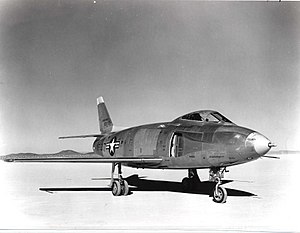North American YF-93
This article needs additional citations for verification. (April 2008) |
| YF-93 | |
|---|---|

| |
| The first YF-93A with NACA inlets | |
| Role | Fighter |
| Manufacturer | North American Aviation |
| First flight | 24 January 1950 |
| Retired | 1956 |
| Primary users | United States Air Force NACA |
| Number built | 2 |
| Developed from | F-86 Sabre |

The North American YF-93 was an American fighter development of the F-86 Sabre that emerged as a radically different variant that received its own designation. Two were built and flown before the project was eventually canceled.
Design and development
In 1947, North American Aviation began a design study, NA-157, to create a true "penetration fighter" to meet the requirements of a long-range version of its F-86A Sabre. In order to accommodate more fuel, a much larger F-86A was envisioned, eventually able to carry 1,961 US gallons (7,420 L), both internally and with two 200-US-gallon (760 L) underwing drop tanks. The new variant possessed a theoretical unrefuelled range of over 2,000 nmi (2,300 mi; 3,700 km), twice that of the standard production F-86A. The resultant fighter originally designated the F-86C was intended to compete with the XF-88 Voodoo and Lockheed XF-90 to fulfill the USAF's Penetration Fighter requirement for a bomber escort.
The F-86C was much larger and heavier, weighing in at 10,640 lb (4,830 kg) more than its antecedent. The increased weight and girth necessitated a dual-wheel main landing gear, increased wing area and a more powerful engine, the Pratt & Whitney J48 rated at 6,250 lbf (27.8 kN) static thrust and 8,750 lbf (38.9 kN) thrust available in afterburner. With the SCR-720 search radar and six 20 mm (.79 in) cannon mounted in the nose where the air intake was on the F-86A, the engineers designed a novel set of flush-mounted NACA inlets.
In December 1947, the Air Force ordered two prototype NA-157s and, considering the many changes to the F-86, redesignated it YF-93A. Both prototypes were built with NACA inlet ducts; the first, (48-317), was later retro-fitted with more conventional intakes. Six months later, the initial contract was followed up with an order for 118 F-93A-NAs. In 1949, the production order was abruptly canceled as priorities had shifted dramatically following the testing of the ground-breaking Boeing B-47 which reputedly would not need an escort due to its high speed capabilities. With the prototype YF-93As just coming off the production line, the USAF took over the project.
Operational history

The prototypes, serial numbers 48-317 and -318, began flight tests in 1950 and were entered in a flyoff against the other penetration fighter projects, the XF-88 and XF-90; the XF-88 Voodoo was declared the winner. None of the projects would be ordered. The YF-93As were turned over to the National Advisory Committee for Aeronautics (NACA) AMES facility for further testing before being utilized as chase aircraft until 1956. Flight with the NACA ducts proved troublesome at high angles of attack, restricting air flow to the engines.[citation needed] By this time, however, higher performance aircraft were available and both aircraft were eventually declared surplus and scrapped.
Operators
Variants
- F-86C
- Original designation for a re-engined variant of the F-86A, two built.
- YF-93A
- Two prototype F-86Cs redesignated,
- F-93A
- Production variant, order for 118 cancelled.
Specifications (YF-93A)

Data from The American Fighter[1]
General characteristics
- Crew: 1
- Length: 44 ft 1 in (13.44 m)
- Wingspan: 38 ft 9 in (11.81 m)
- Height: 15 ft 8 in (4.78 m)
- Wing area: 306 sq ft (28.4 m2)
- Empty weight: 14,035 lb (6,366 kg)
- Gross weight: 21,610 lb (9,802 kg)
- Max takeoff weight: 26,516 lb (12,027 kg)
- Powerplant: 1 × Pratt & Whitney J48-P-6 turbojet, 6,000 lbf (27 kN) thrust dry, 8,750 lbf (38.9 kN) with afterburner
Performance
- Maximum speed: 708 mph (1,139 km/h, 615 kn) at sea level, 622 mph (1,001 km/h; 541 kn) at 35,000 ft (11,000 m)
- Cruise speed: 534 mph (859 km/h, 464 kn)
- Range: 1,967 mi (3,166 km, 1,709 nmi)
- Service ceiling: 46,800 ft (14,300 m)
- Rate of climb: 11,960 ft/min (60.8 m/s)
Armament
- Guns: 6× 20mm M24 cannon (proposed, not fitted to the prototypes)
See also
Related development
References
Notes
- ^ Angelucci and Bowers 1987, p. 352.
Bibliography
- Angelucci, Enzo and Peter Bowers. The American Fighter. Sparkford, UK: Haynes Publishing Group, 1987. ISBN 0-85429-635-2.
- Davis, Larry. F-86 Sabre in action. Carrollton, Texas: Squadron/Signal Publications, 1992. ISBN 0-89747-282-9.
- Pace, Steve. X-Fighters: USAF Experimental and Prototype Fighters, XP-59 to YF-23. Osceola, Wisconsin: Motorbooks International, 1991. ISBN 0-87938-540-5.
- Sgarlato, Nico and Franco Ragni. U.S. Fighters of the Fifties. Carrollton, Texas: Squadron/Signal Publications, 1979. ISBN 0-89747-090-7.
- Wagner, Ray. The North American Sabre. London: Macdonald, 1963. No ISBN.
